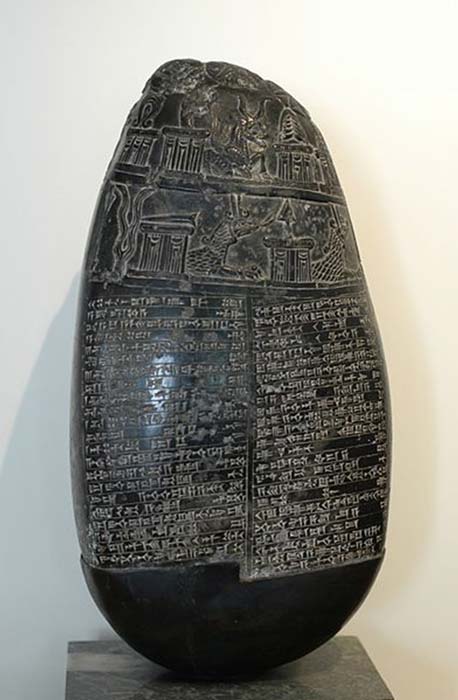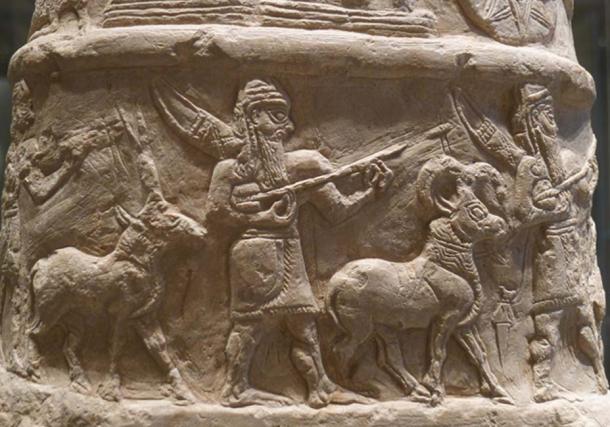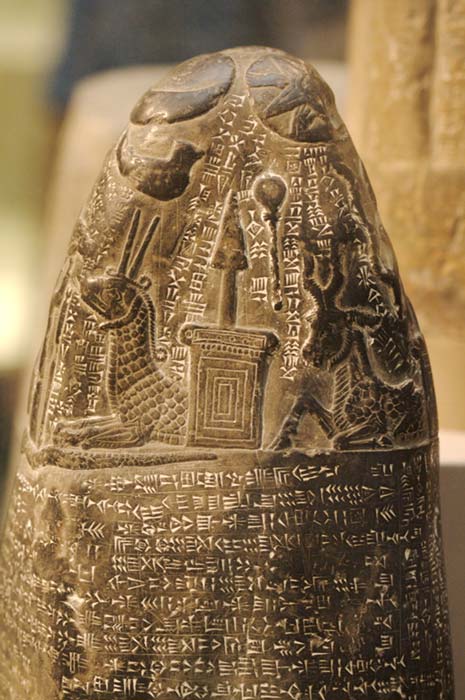Posts Tagged ‘mythology’
Kudurru? (meaning ‘boundary’ or ‘frontier’ in Akkadian civilization). Land grants, bestowed by the king onto a person.
By Wu Mingren
While stone monuments have been used at various times in ancient Mesopotamia, it is especially associated with the Kassite period. The kudurru served as a record of gifts, especially land grants, bestowed by the king onto a person.
Today, examples of these boundary stones are exhibited in Museum.
The Origin of the Kudurru
Prior to the Kassite period (known also as the Middle Babylonian period), which lasted from around the 16 th century BC to the middle of the 12 th century BC, stone monuments like the kudurru were already being produced. These were known as narus.
It was only during the Kassite period that kudurrus began to be made. These were highly polished stone, normally limestone, slabs / blocks onto which royal grants were recorded.
The kudurru derived its name from the fact that these gifts usually took the form of land grants . Although one might imagine that the kudurru was used to physical mark the boundaries of a person’s land, this was not the case.
Instead, a kudurru would have been kept in a temple, while a clay copy of the original was given to the landowner.

Babylonian kudurru of the late Kassite period. (Rotatebot / Public Domain )
Kudurrus Were Considered Sacred
For modern scholars, kudurrus also provide some insight into the religious beliefs of the ancient Mesopotamians. Since kudurrus were kept in temples, an indication that they had some sacred value attached to them.
They were meant to be visible not only by worshippers who came to the temple, but also by the gods. The association with the divine realm is also evident in the imagery carved onto these stones.
In general, all the gods responsible for the preservation of the universe are depicted on the kudurru. The gods are arranged in rows according to their position in the divine hierarchy and are represented by their symbols.
The ordering of the gods on these boundary stones reveals to us the beliefs held by the ancient Mesopotamians regarding the organization of both the cosmos and the divine realm.

A kudurru, boundary stone, from ancient Mesopotamia. (Mbzt / CC BY-SA 3.0 )
The top row of the stone was reserved for the astral deities – the moon god, Sin, the sun god, Shamash, and the goddess of Venus, Ishtar.
The next row was occupied by the sky god, Anu, the air god, Enlil, the god of freshwater, Ea, and the earth goddess, Ninhursag.
These were important gods , as they were responsible for maintaining the equilibrium of the universe.
In some instances, there is a line separating these gods from the astral deities, while in others they are placed together.
The next three rows were occupied by the warrior gods, the gods in charge of the earth’s fertility, and the deities of the underworld respectively.
What Was the Purpose of the Kudurru?
Like the arrangement of the deities, the text inscribed on kudurrus also follows a certain order. The text may be divided roughly into 2 parts..
The first part contains the nature of the land grant, as well as the clauses attached to it, whereas the second part contains a list of curses to deter anyone from violating the agreement.
These curses called upon the gods to punish those who violated the agreement.
Thus, the land grants documented on the kudurru were not merely contracts made among human beings but also with the gods, and those who dared break them risk divine retribution.

The text on the kudurru described the land grant and conditions. (Dudubot / CC BY-SA 2.0 )
Although the Kassite period came to an end around the middle of the 12 th century, the popularity of the kudurru continued and is considered to be a legacy of this dynasty.
This is evident, for instance, in the kudurrus dating to the reign of Nebuchadnezzar I, a ruler of the Isin dynasty.
This was the dynasty that succeeded the Kassites . Kudurrus have been unearthed by archaeologists and are on display in various museums around the world today including the British Museum and the Louvre Museum.
Top image: The engraving of the gods depicted on the kudurru were arranged in a particular order. Source: Jastrow / Public Domain
By Wu Mingren
- Lost Years of Nabonidus, Last King of the Neo-Babylonian Empire
- Cursing Stones of Ireland: When Christianity and Pagans Pooled Their Sacred Water
- Nabopolassar: The Rebel Ruler of Babylonia Who Had the Gods on His Side
Note: Updated from 2019 article
The myths in the Ancient Testament are all altered versions of stories thousands of years old of the Land.
Posted on: March 23, 2024
The story of the 6 days formation of earth is a Babylonian myth.
The story of Adam and Eve is an altered Canaanite myth found in Ugarit and the story drastically changed.
The story of Noa is a Sumerian myth found in the Gilgamesh adventures.
The “Jews” or the amalgam of tribes never crossed the Nile fleeing the Pharao army. Actually, there were No Jewish sect before 200BC: The first 5 chapter for a new religious sect were copy/past from ancient narratives.
The 10 commandments of Moses are Hammurabi commandments.
There was never any Jewish kingdom, neither the individuals such as David nor Solomon…
Facts are that in those periods, scholars could read the ancient tablets in their original languages and did Not need our archeologists to decipher these languages.
Facts are that 2 thousand years ago, the common people in Iraq, Syria, Palestine, Lebanon… were familiar with all these mythical stories since antiquity. And the scholars could read the tablets in their original languages.
Most the western celebrations such as Mother Day (exactly on march 21st), Spring Day...are thousands of years old. The newly Christian Byzantine empire considered all these celebrations as pagans, though they gave them a few liturgical connotations in order Not to antagonize thousands of years of traditions. In those days, the new year was celebrated on April 1st.
The sentence “Son of God will be begot from a virgin…” could be read in an Ugarit tablet, the first recognized alphabet characters.
Ali Nasseraldin reposted the article of حسن غزلان (Hassan Ghazlan).
لقد اثبتت الاكتشافات وترجمة المخطوطات والالواح الحضاريَّة ما يلي :
1- سفر التكوين في 6 ايَّام هو اسطورة بابليَّة
2-قصَّة آدم وحواء اسطورة كنعانية وجِدت في اوغاريت
3-قصَّة طوفان نوح هي أسطورة سومرية تعود الى ملحمة جلجامش 3500 قبل المسيح ولم يستطع أحد لغاية يومنا هذا من إيجاد بقايا أو أي أثر يدل على وجودها…
4-قصة عبور موسى واليهود للبحر الاحمر وغرق فرعون هي اسطورة ولم تحصل في التاريخ واليهود لم يذهبوا الى مصر ولا خرجوا من مصر ولا يستطيع احد ان يذكر متى غرق الجيش المصري في البحر الاحمر ولا من هو الفرعون الذي غرق هناك ولم يجد الباحثون اي هياكل عظمية او عربات او بقايا اسلحة في البحر الاحمر…
5-ما يسمى وصايا موسى أو ناموس موسى هي شريعة حمورابي ومن لا يصدق ليقرأ قوانين حمورابي ويقارن بنفسه ..
6-مملكة داوود خرافة وليس لها اي أثر في أرض فلسطين….
7-مملكة سليمان خرافة..
8- حفريات اليهود تحت المسجد الأقصى لم تكتشف اي حج7ر او فخارة يهودية..
إذاً كل تاريخ اليهود خرافة وهي أساطير سورية قديمة وحين نقول سورية نقصد سورية الطبيعية وتحديداً كانت الاساطير تكتب في بلاد مابين النهرين أي الشِّام والعراق سرقها اليهود وكتبوا منها تلمودهم المزوَّر …
حتَّى الطقوس السُّومريَّة سُرقت وجعلوها عادات وطقوس عربيَّة إسلاميَّة فالصُّورة توضِّح كيف كان السُّومريُّون يصلُّون لآلهتهم فإن كان مايقوله أصحاب المعارف صحيح بأنَّ الفتح العربي هو بداية الحضارة وماقبله كان عصر الجهل والإلحاد فلماذا يستخدمون طقوسنا السومرية في صلاتهم ؟؟؟؟
إن الحقيقة مربكة ومخيفة وأكثر ما يخيفنا فيها هو إيجاد البديل عمِّا نؤمن به أو نعتقد بوجوده وإن لم ننهض ونتمرِّد على التِّزوير والتضليل سنبقى في سبات الظَّلالة قرون أخرى ولن نستفيق إلا بعد أن نصبح غُرباء في أرضٍ هي لنا وملكنا منذ 13500 عام وأكثر…
بعد كل ما ذكرناه يخرج علينا من يقول أننا لسنا أصحاب حضارة وتاريخ \
دمتم للحق والجهاد لتحي سورية أرض الخلود..
__________
شاركوا حقيقتكم وافخروا بأصلكم السوري العريق
كتب المقال ( الرفيق الغزال – حسن غزلان).
See Translation

